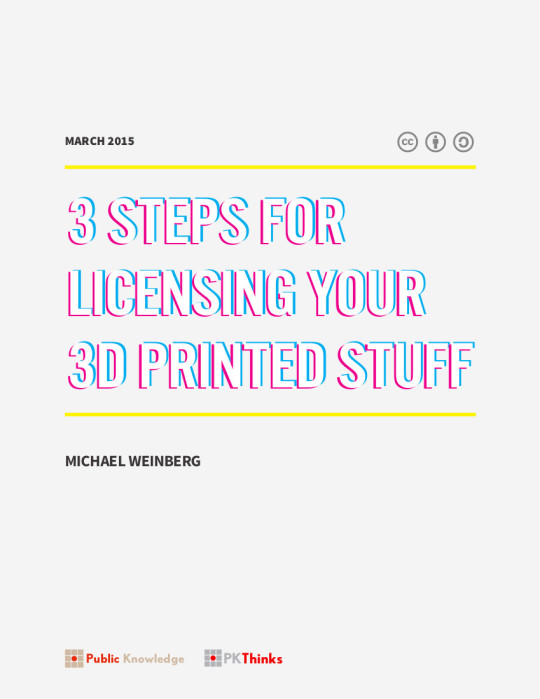
This is the third 3D printing whitepaper. It was also the last big thing I wrote for PK. The paper focuses on what parts of 3D printable objects (and files) might be protectable by IP and what happens if those parts are protected. The title is kind of a lie. It spends much more time talking about what you might be able to license than how to license those parts after you have identified them.
The original announcement post is below. You can download the paper here
The expiration of patents, as well as a worldwide effort to engineer open, low-cost desktop 3D printers, has begun to fundamentally alter an industry that had been flying under the radar for decades. However, as 3D printers become more accessible to more people, questions of ownership and control of 3D printed objects begin to arise more often.
It should come as no surprise that many people turn to copyright law to answer these ownership and control questions. Indeed, one of the unexpected side effects of the past generation’s growth of software and the internet has been a collective, informal public education in copyright and copyright licensing. In light of this history, it is only natural that 3D creators’ instincts lead them to the General Public License (GPL), Creative Commons (CC) licenses, and other similar licenses to determine how others can—and cannot—use their creations.
Unfortunately, this instinct is not always the right one. From an intellectual property law standpoint, physical objects are quite different from code or words or photographs. Code (and words and photographs) is categorically eligible for copyright protection, and that protection attaches automatically. The GPL, CC licenses, and other licenses geared towards code all function under the assumption that the underlying work exists well within the scope of copyright protection and is therefore protected by copyright.
This assumption is not as easily applied to the world of physical objects. Some physical objects are protected by copyright, but many others are not. Additionally, the copyright in the digital files that represent those physical objects can require an entirely different copyright analysis than the one for the objects themselves.
In light of that, this paper is not actually about choosing the right license for your 3D printable stuff (sorry about that). Instead, this paper aims to flesh out a copyright analysis for both physical objects and for the digital files that represent them, allowing you to really understand what parts of your 3D object you are—and are not—licensing. Understanding what you are licensing is key to choosing the right license. Simply put, this is because you cannot license what you do not legally control in the first place. There is no point in considering licenses that ultimately do not have the power to address whatever behavior you’re aiming to control. However, once you understand what it is you want to license, choosing the license itself is fairly straightforward.
Finally, in discussing licenses, this paper mostly focuses on open licenses, such as the GPL or Creative Commons licenses. This is in part because many 3D object creators gravitate towards these types of licenses. It is also because supporting open culture is important to both Public Knowledge and me. However, the fundamental analysis of what is and is not protectable by copyright applies to any license regime and can be used in support of any type of copyright license.
Download it here.